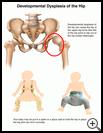
Hip Spica Cast
What is a hip spica cast?
A hip spica cast keeps your child’s hips and legs from moving while your child heals from a hip or leg problem. The cast may be made with hard plaster or fiberglass. The cast starts at the chest and may stop at the knee, or may go all the way down one or both legs. There is often a bar between the legs of the cast to help keep the legs from moving. The cast has an opening for diapering or toilet use.
When is it used?
Most often a hip spica cast is used to correct hip problems in babies, such as a loose hip joint or dislocated hip. A hip is dislocated when the top of the upper leg bone (the ball of the hip joint) slips out of the hip socket. The cast may also be used if your child has a broken thighbone.
How can I take care of my child?
Children often need to be in a spica cast for 8 weeks or longer. It’s very important to protect the cast and keep it dry so that it does not cause problems and need to be removed. Taking a child out of a spica cast before the leg or hip has healed may make it harder for your child to heal.
- Keep the cast dry.
Urine or moisture can get the cast wet. If the cast gets wet or soiled, it may soften, crack, or get so dirty that it needs to be replaced. Children who are still in diapers will need frequent diaper changes to help protect the cast. It may help to put 1 diaper under the cast and a larger one on top of the cast, but be sure to change the diapers before the cast gets wet. If urine or bowel movements get on the cast, clean it with a slightly damp cloth.
Your child’s healthcare provider will tell you how to keep your child clean. Instead of a bath, you may need to use a damp sponge or cloth to wash your child.
- Take care of your child’s skin.
Make sure that the spica cast does not get too tight and rub against your child's skin. Make sure your child’s toes are pink and warm.
If it looks like your child is having a lot of itching, try using a hair dryer on the cool setting to blow air over the itchy skin.
Don’t use lotion or powder inside the cast or on the skin at the edges of the cast. Powder can cake, and lotion can make the skin more likely to develop sores.
If your child is in one position too long, your child might start having irritation, redness, or sores. Change your child’s position often to avoid these problems. Your healthcare provider will show you how to position your baby and how often to change positions. If a particular area is uncomfortable, position your child so that there is less weight on that area. Keep your child comfortable.
- Help your child avoid constipation and diarrhea. Older children should drink extra fluid and eat plenty of fruits and vegetables. Avoid fruit juices and new foods that may cause diarrhea.
- The cast is bulky, so you may need to get larger sized clothing for your child. Velcro fasteners can help you dress your child more easily.
- When your child needs to ride in a car, make sure you have the right kind of car safety seat. You may need to rent a special car seat. Bring your child’s car seat to your healthcare provider to see if your child can use it with the spica cast.
- Follow your child’s healthcare provider's instructions. Ask your provider:
- How long it will take for your child to recover
- If there are activities your child should avoid and when your child can return to normal activities
- How to take care of your child at home
- What symptoms or problems you should watch for and what to do if your child has them
Make sure you know when your child should come back for a checkup.
Last modified: 2017-04-11
Last reviewed: 2017-04-11

